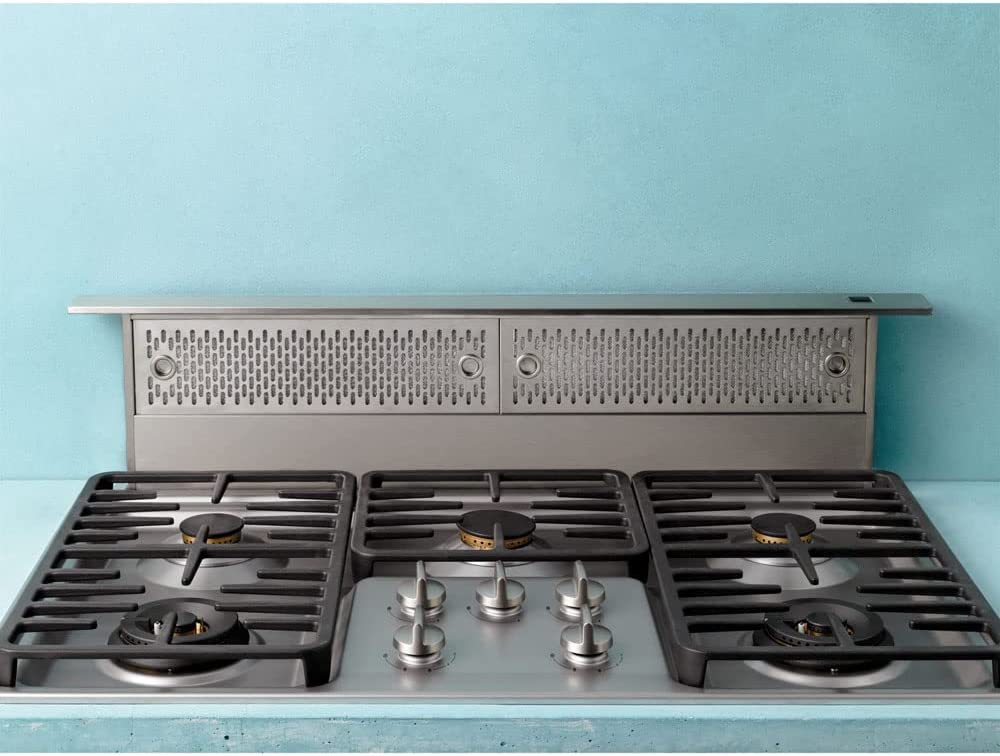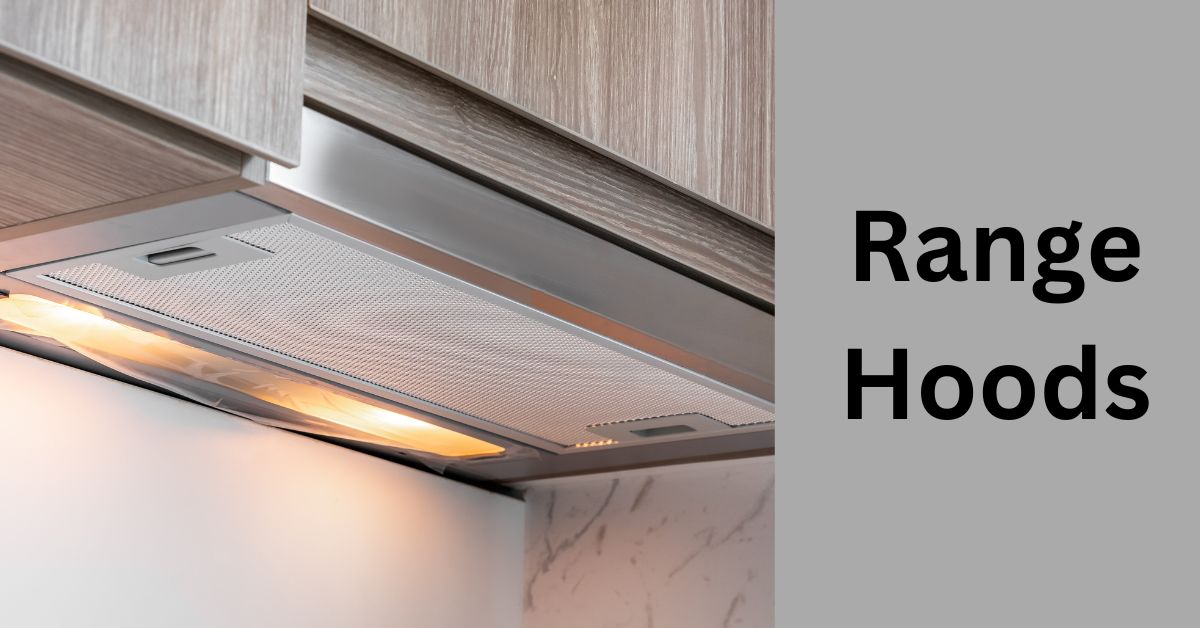Table of Contents
Note: If you came to this post on range hoods through a random search, please click on this parent page and our home page for more context.
The Range Hood – An Early Decision
The range hood is an important part of any kitchen remodel or renovation. And it can have direct benefits respecting aging-in-place applications.
If you intend to install a range hood, you must select it early in the remodeling process. This is because other things must be designed to accommodate it. This includes cabinetry and electrical.
Plus the range hood has a definite impact on the design aesthetic of your kitchen. And you need to think that through in advance.
But first, is a range hood necessary?
Do You Really Need a Range Hood?
Most local building codes do not require the installation of a range hood. But it’s a good idea to check this out before deciding whether or not to install a range hood.
Second, consider how much cooking you do or plan to do. If the answer is “not much,” then you might forgo the expense and undoubted obtrusiveness of a range hood.
But, third, you also need to consider the impact on the value and marketability of your property. Many buyers will simply expect to see a range hood in the kitchen and may just move on if they see there isn’t one.
If you are still resistant to the idea of a range hood, you could consider the alternative of a downdraft range. More on this later.
Nonetheless, our own overall take and recommendation on this question are that you should install a range hood.
What is the Purpose of a Range Hood?
The exquisite aromas of cooking come with undesirable by-products. The process of cooking food, especially frying it, releases odors, smoke, and particles into the air. These can linger well after food preparation is over.
In addition, all this greasy airborne material will settle on the horizontal surfaces of your kitchen and stick to its vertical surfaces. All this can build up and become unsanitary.
A range hood is basically a large inverted funnel located over the range that uses a fan to collect and extract the fumes, humidity, and airborne particles generated by the cooking process. A vented range hood will eject all of this into the atmosphere outside the home.
An efficient range hood will clean the air and make for a better living environment. It has useful ancillary functions too:
- Provide additional lighting to make cooking easier and keep the cooking area safer
- Reduce the risk of carbon monoxide accumulation
- Remove hot air to keep the range area cool
- Prevent activation of smoke detectors reacting to cooking smoke
Vented vs Ductless Range Hoods
Which is better, a ducted or ductless range hood?
Ductless (or recirculating) range hoods feature charcoal filters that trap particles generated by cooking and keep them from circulating back into the kitchen. They can include automatic alerts to change or clean the filters.
However, ductless hoods do not actually extract and exhaust polluted air from the kitchen to the exterior. And they do not remove any of the humidity caused by the cooking process. Plus, regularly replacing the filters is a nuisance and an ongoing expense. A ductless range hood only provides filtration. It does not provide ventilation.
Vented or ducted hoods, which do extract and exhaust the air, are much more efficient but they are more difficult and expensive to install. So it’s a trade-off.
There is no doubt that a ductless hood can be helpful but it is not recommended if you can avoid it. If you do decide on a ductless system, you might want to supplement it by adding a portable air purifier to the kitchen.
Convertible Range Hood
Many range hoods are convertible. This means that the range hood can be installed such that it will vent to the exterior but can also be converted to a recirculating or ventless hood.
How to Choose a Range Hood?
Here are the things to look for in a range hood:
Air Handling Capacity
The most important consideration is how much air should the range hood be able to move to be effective in your kitchen. This air handling capacity is measured in CFM or cubic feet of air per minute.
The Home Ventilating Institute (HVI) recommends four sets of criteria.
1: Based on the heat output of your range. You divide the BTU rating for your range by 100. So if your range is rated at 40,000 BTU, your range hood should have a capacity of 400 CFM or more.
2: Based on the width of your range. If your range is against the wall, you should have 100 CFM of air capacity per 1 linear foot of range width. So if your range is 3 feet wide, the minimum capacity of your hood should be 300 CFM
If your range is on an island, you should have 150 CFM of air capacity per 1 linear foot of range width. So if your island range is 3 feet wide, the minimum capacity of your hood should be 450 CFM.
3: Based on the size of your kitchen. The HVI recommends a complete kitchen air change 15 times per hour. This is equivalent to 4 times per minute. For example, if your kitchen is 15’ x 10’ with a ceiling height of 8’, the volume of air in the room is 1200 cubic feet.
You then divide the 1200 cubic feet by 4 air changes per minute to arrive at a desired air handling capacity for the range hood of 300 CFM.
4: Adjusting for ductwork. Forcing air through ductwork causes friction and requires additional extracting power. So add 1 CFM for each foot of ductwork plus 25 CFM for each elbow. Obviously, the shorter the duct the better.
So the recommended method for establishing the desired CFM is to go with the largest capacity calculated by the first 3 criteria and then make the adjustment called for in #4.
Fan Speed
Look for a range hood with at least three fan speeds.
Lighting
Look for dimmable LED lighting. Look for an emergency safety light. Range hoods come with many different lighting packages.
Range hood lighting is particularly important for an aging-in-place remodel because it brings a light source close to the cooking surface. This is good for the elderly in both safety and function.
Heat Sensors
The range hood should have sensors that turn the fan on when the air in the hood reaches a certain temperature.
Automatic Shutoff
Look either for sensors that turn the fan off when the temperature is cooled to a given level or a timer shutoff.
Remote Operation
Look for a remote control option, so you do not have to reach up over a hot range to select a control setting.
Style & Installation
Whether ducted or ductless, the range hood serves as an important statement of style for the kitchen and affects its aesthetic appearance. Most range hoods are stainless steel and are generally the least expensive. Other range hoods are clad in many different types of decorative material.
The range hood’s aesthetic impact depends on its location. Obviously, a range hood over the kitchen island makes more of a statement than an under-cabinet wall location.
As to the physical sizing and installation of the range hood, the optimal is:
- The hood width should extend 3 inches beyond each side of the range or cooktop
- The hood should be 20 to 24 inches above an electric cooking surface.
- The hood should be 24 to 30 inches above a gas cooking surface
We’ll now look at the main range hood types and styles and illustrate them with what is available on Amazon:
Under-Cabinet Range Hoods
The under-cabinet range hood is the most common type of range hood. It is located immediately beneath the cabinetry over the range and protects the wood from heat. Some are ducted to the exterior, and others recirculate.
Wall-Mounted Range Hoods
Wall-mounted range hoods are normally vented to the exterior and have no cabinetry above. They make a design statement but you have to consider the cabinet storage space you are missing out on.
IKTCH 30-inch Wall Mount Range Hood
- Ducted/Ductless Convertible
- Gesture Sensing & Touch Control Switch Panel
Ceiling Mount Recessed Range Hood
These are hoods that are actually recessed into the ceiling and positioned directly over the cooktop. They are vented through ductwork to the outside of the home.
For best results, these hoods need to be much larger than the cooktop area (say 48” for a 36” cooktop. Plus they need to be no more than 4’ above the cooking surface. So these may be fine for an 8’ ceiling but, without a great deal of soffiting down, will not work for a 10’ ceiling.
Some of these hoods will also work as cabinet inserts.
Kitchen Island Range Hoods
Kitchen island range hoods are suspended above the island and may or may not be vented to the exterior. They make an impactful architectural statement.
Downdraft Range Hoods
Downdraft range hoods are not strictly range hoods but attempt to serve the same function. They extract cooking fumes and smoke from the (usually) kitchen island range or cooktop area and exhaust them through a plenum under the floor to the exterior of the home.
They are relatively inefficient because the hot air and smoke naturally tend to rise and escape the sideways suction of the extractor fans. However, they do offer the benefit of avoiding the view-blocking effect of a suspended kitchen island range hood.
Some cooktops incorporate their own downdraft system. An alternative is to retrofit an existing cooktop with a separate downdraft system.

Are Downdraft Range Vents Any Good?
The answer to this question needs context. First, downdrafts have very high CFM capacity. And they need it because, compared to the regular range hood, they have no natural capture area.
Downdraft range hoods are incapable of handling any professional caliber range. Heat rises and the fact that the downdraft intake riser is adjacent to (not above) the cooking surface, makes it impossible to capture all the air that rises from the cooking operation.
That said, downdrafts do have their place. An island or peninsula range hood may be difficult to install and you may not want it blocking the view anyway. And downdrafts can be a good solution when you are using an induction cooktop, which does not generate much heat.
Decorative Range Hoods
Many decorative range hoods have been developed to embellish upon or perhaps take the edge off the intrusiveness of the architectural statement made by the range hood. Here is an example.
Range Hood Fire Suppression
A range hood fire suppression system is required in commercial applications. They are very expensive. But for your kitchen consider this rangehood fire suppressor on Amazon. Regardless, always have a fire extinguisher on hand in your kitchen.
Kitchen Design Context
When contemplating your choice of range hood, be sure to keep in mind your kitchen design intent.
- Related post: Kitchen Remodel Overview & Checklist
- Related post: Kitchen Layout
- Related post: Kitchens for the Elderly
- Related post: Oven Selection














Leave a Reply